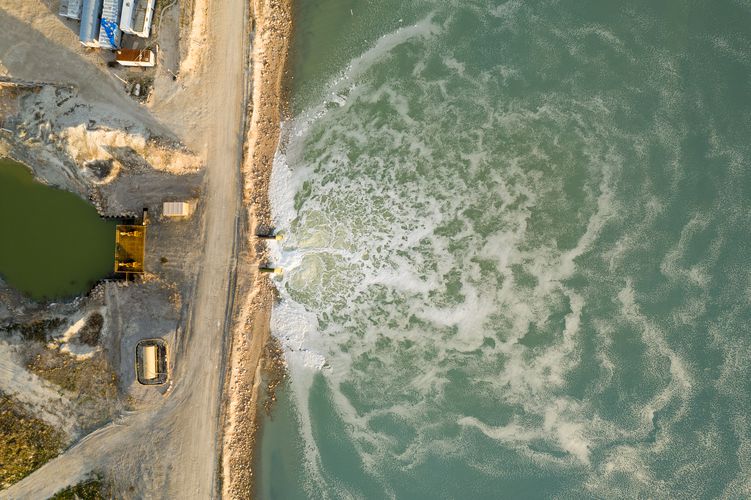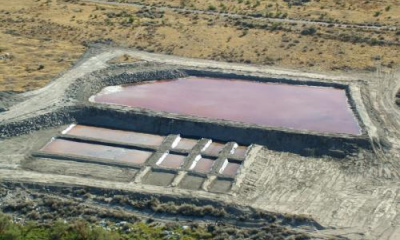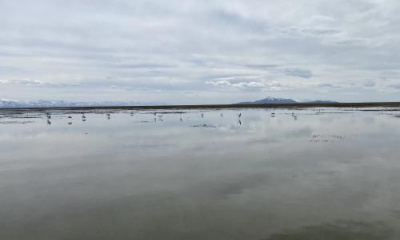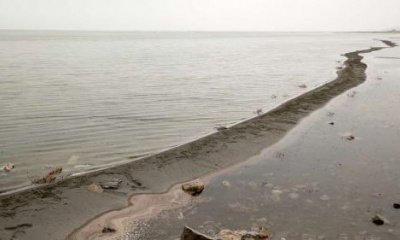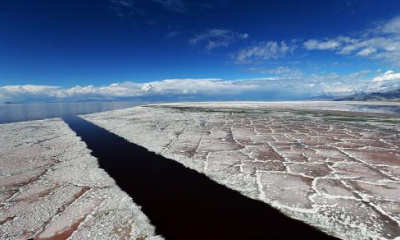Environmentalists worry that siphoning off more water is exactly what the shrinking lake doesn’t need.
The Great Salt Lake is so low that one of its largest lake-based businesses, US Magnesium, is urgently seeking to extend its intake canals.
The company extracts magnesium and other minerals by diverting lake water and concentrating the brine through solar evaporation. But as the Great Salt Lake continues to shrink, the company is having trouble pumping water through the canals that fill its evaporation ponds. That’s having ripple effects on other businesses, like nearby salt operations that use the canals and brine shrimp harvesters that launch their boats through them, according to Tom Tripp, director of technical services for US Magnesium.
“We applied on an emergency basis two years ago,” Tripp said. “This is way overdue.”
The company’s application went to the U.S. Army Corps of Engineers, which began evaluating the permit request last month. A representative with the corps did not respond to a request for comment for this story.
The plan calls for dredging two canals so US Magnesium can stay operational if the lake sinks to 4,185 feet above sea level. The lake plunged to a record low of 4,190.1 feet on July 3 and has continued to recede in the sweltering days since. It sat at 4,189.2 feet as of Tuesday.
“I’m hoping the lake will not go down to 4,185,” Tripp said. “We will have some experiences no one wants to have.”
Dropping the elevation that low would expose more lakebed and kick up more toxic dust. Receding water also concentrates the lake’s salinity. Higher levels of salt threaten the life cycles of the brine shrimp, brine flies, algae and microbes that live in the water.
“If you get to an elevation like that, the lake will saturate and you’ll collapse the food chain,” Tripp said. “Salt falls out of the water and accumulates on the bottom. And that will take everything with it.”
One need only look to the Great Salt Lake’s north arm, which is cut off from freshwater sources due to a railroad causeway, to see the impacts of spiked salinity. That section of the lake has been at saturation for years.
“There are no brine shrimp up there,” Tripp said, “no brine flies.”
US Magnesium’s application calls for lengthening a 1.1-mile canal, called P-N, another 0.7 miles and a second 2.6-mile canal, called P-0, another 3 miles. The project would dredge about 127 acres of lakebed.
The proposal worries some environmental groups.
Balancing the lake’s industry with its environmental needs
Lynn de Freitas, executive director of FRIENDS of Great Salt Lake, pointed to the Utah Legislature’s recent adjustments to state water law that provide more tools to get water to the struggling lake, like water banking and water right leasing. Extending canals so industries can potentially siphon away more water in the lake, said warned, runs counter to those goals.
“If you’re bringing water into the system while at the same time you’re sucking water out of the system,” de Freitas said, “it’s really contrary to what you’re trying to achieve.”
FRIENDS submitted comments to the corps last week detailing the hemispheric importance of the Great Salt Lake’s ecosystem, including the habitat it provides to more than 10 million migrating birds. At least two of those species, eared grebes and Wilson’s phalaropes, the document said, could be candidates for an endangered species listing if the lake’s decline continues.
The nonprofit called on the corps to conduct a thorough environmental impact study before approving any dredging permit, especially as the scientific understanding of increased salinity’s impacts on the lake continues to evolve.
“The only reasonable and practical compensatory mitigation would be for the corps to require US Magnesium to obtain and donate water rights for Great Salt Lake,” FRIENDS said in its comments, “that are equal to the amount of water that the company plans to extract from the lake as a result of this permit.”
How much water does mineral extraction use?
US Magnesium has water rights to take up to 144,790 acre-feet from its canals, according to the Utah Division of Water Rights website.
Last year, US Magnesium diverted 41,457.54 acre-feet from its P-N canal and no water from its P-0 canal. In total, all the water the company consumed from the canals, wells and springs it has rights to totaled just over 45,000 acre-feet, compared to about 67,000 acre-feet the year before. In normal years, Tripp said, it has used up to 130,000 acre feet.
“Mineral extraction companies are not taking as much [water] as they can take,” Tripp said. “They’re taking the minimum they can take to stay in business.”
As lake levels fall, extractors like US Magnesium divert less water because the minerals are concentrated, he added.
By comparison, Salt Lake City’s 85,000 residential, commercial, industrial and institutional customers used just under 69,000 acre-feet of water in 2021. Ogden’s roughly 27,000 retail connections used about 14,000 acre-feet (although this doesn’t include the city’s secondary water consumption). Provo’s 19,000 retail connections used about 24,000 acre-feet.
And a 2020 evaluation by Utah State University found that mineral extraction accounts for 13% of the water consumed that would otherwise go to the Great Salt Lake, versus 63% that goes to agriculture. Cities use about 11% of the water in the lake’s basin, while 3% is lost to evaporation in reservoirs.
“Everyone’s looking for ways to make the most out of the fewest resources,” Tripp said. “... I want the message out there that the extraction companies are cognizant of this thing. They’re aware of the low lake levels.”
Tripp also pointed to the vital role Great Salt Lake minerals play in the state and nation. The industry contributes $1.3 billion a year to Utah’s economy, according to a 2019 report prepared for the Great Salt Lake Advisory Council.
Compass Minerals, which operates on the north end of the lake, produces an important component to the fertilizer used to grow fruits and nuts. US Magnesium, on the lake’s southern end, is the only domestic source of magnesium, which is used in a vast array of products from soda cans to car parts to pharmaceuticals. The U.S. Geological Survey this year declared it a critical mineral for national security and supply chains.
Both Compass and US Magnesium are also working to produce lithium, a crucial part of the batteries that power electric vehicles.
With all that in mind, the Utah Division of Forestry, Fire and State Lands has a difficult balance to maintain. It issues leases to mineral companies on the lake, collecting royalties that benefit the state. The division is also charged with finding ways to bring more water to the lake and improve its health, funded at least in part by mineral royalties.
“For me to take a stance on whether or not they should be removing the brines is a tough one,” said Ben Stireman, sovereign lands program administrator for the division. “We’ve supported the minerals industry for many years on the Great Salt Lake. [But] it’s a tough time to be putting any pressure on the lake when we’re hitting historic lows and seeing salinity levels rising.”
Stireman confirmed that Compass Minerals has also expressed interest in extending its intake canals.
Dredging canals to 4,185 feet would take US Magnesium to the edge of the lakebed footprint it leases from the state. When division officials created a matrix in 2013 of salinity impacts at various lake levels, it’s an elevation so low they didn’t even consider it.
“We hadn’t contemplated breaking new records” back then, Stireman said. “... But the level they’re wanting to dredge down to is not surprising, given the current level of the lake.”

